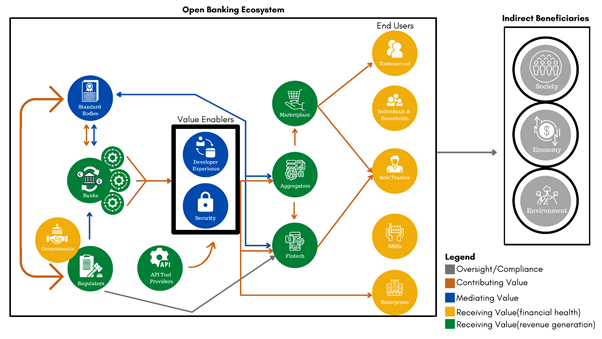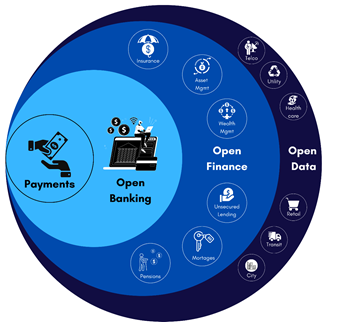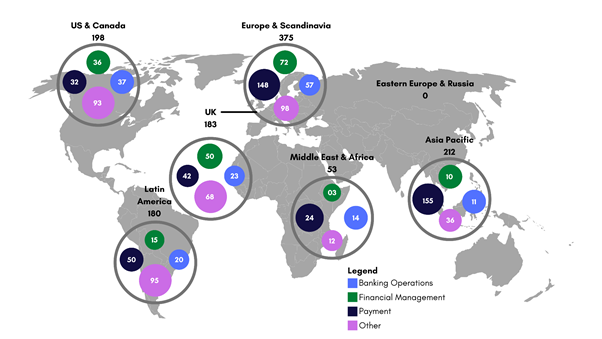The banking and financial services domain is transforming into a more fragmented and modularized structure. Industry gurus believe this transformation is here to stay. They believe swift adaptation of this phenomenon is critical to identify the implications on business models and alignment of strategic response. New technology is making it easier for customers to buy from multiple product providers. The number of financial products used by the average customer is increasing. This is called modularized pulled demand.
This modularization has forced both the incumbents or traditional FI’s and new entrants or Fintech FI’s to collaborate with each other to cater to micro-segments. This fragmentation has cracked all forms of entry barriers to new players and tech giants to grab a substantial share of the pie from large traditional players.
What is Open Finance and Its Ecosystem
Open banking has set the pace for enterprising differentiations within the financial services ecosystem. Amidst these latest developments, industry gurus and regulators are drawing emphasis to the data-driven financial ecosystem. Sharing data formulates the basis of creating an indistinguishable battlefield amongst the service providers.
Whilst banks are not yet to consider where they will play in the open data economy, tech companies are marching ahead to grab the opportunities open data economy has to offer. For instance, companies such as WeChat, Grab, GoJek, Jio & Tink have exploited the opportunities open data economy has to offer.
Open finance brings together a host of new players and service providers other than banks & FI’s to the finance ecosystem by virtue of sharing data. Telcos, tech giants, microfinance entities, eCommerce, utility providers, rating agencies, realtors, government entities, super apps and SMB’s are exploring avenues to jointly enlarge their ecosystem through collaboration.
The open finance phenomenon is based on if all entities are willing to share respective data, the consumer doesn't have to collate information from various data sources to avail financial services from respective financial asset creators. Typically the real value of data is derived through a combination of data sets collated from various sources, e.g., if a customer is willing to purchase a handset from a telco e-commerce portal, this experience can be made seamless, provided telco can avail customer’s digital KYC, credit rating, financial history, handset supplier information and FI’s to offer a hire-purchase offering, thus telco can in real-time offer the customer a hire-purchase plan, i.e. BNPL option.
Fig: Our model maps how Open banking & Open Finance Ecosystems can generate value for everyone
Drivers of Open Finance
With the rapid influx and emergence of Third Party Providers (TPP’s) entering into the financial ecosystem offering services such as Wealth Management, Investment plans, Mobile Money, Digital Currencies, FOREX, Insurance, Remittance, SuperApps, payments, Credit Decisioning, and budgeting, as a result of these TPP’s the financial ecosystem has stretched its capabilities of service innovation and co-creation.
Digital Native Customer - Gen Y and Gen Z customer segments are the most Digital Savvy generations compared to any previous generation. By nature these customer segments expect any service to be delivered in digital form as opposed to otherwise. These customer segments expect seamless service delivery on their smart devices or even IoT devices. In addition, it is vital to prompt these customers with the most attractive & personalized deal at the most appropriate time. With rich and more contextual data at disposal, the open finance ecosystem is able to create unique and personalized deals; https://www.dealwise.app/en/index.html
Partnerships & Collaboration is the Mantra
Open finance addresses the challenges of data fragmentation by providing a secure and efficient means for customers to allow businesses to share and use customer data across a common framework. A freer exchange of data can let in new competitors and encourage innovation.
Platform API economy has paved the fundamentals for FI’s, Tech giants, service providers, SMB’s eCommerce players to relook at the way of distribution. Every organization today focuses on digital distribution, due to its inherent benefit of reaching the customer through opti-channel & seamless experience. Partnership and collaboration enrich silos of data held by individual entities into more unified, augmented, and complementary data for services provided to create personalized products and services.
- Combine Personal Financial Management (PFM) with other data sources to provide more accurate value propositions. Predominantly PFM applications analytics and predictions are on limited payments data which only allows consumers a narrow financial view. Open finance can contribute to these PFM by adding other data sources beyond transactions to create more personalized propositions.
- Creates a more cohesive conducive and collaborative ecosystem between FI’s, Tech companies, Regulator and Businesses. An open finance ecosystem will facilitate the fabrication of more compelling value to all stakeholders equally creating more opportunities for cross-sell and upsell to a more relevant target micro-segment.
- Unified and Unique Pension Schemes, Open Finance will enable various social security, pension schemes, or other welfare funds to share silos of data sets to unify the plans using a common KYC, thus facilitating the ecosystem to co-create more unified plans customized products and services along with more refined customer-worth.
Impact on traditional banking
We believe with its inherent nature, Fintech’s role in Open Fiance will be to act as the “service curator” orchestrating the innovative service propositions to end users in conjunction with the other stakeholders. Fintech\s will add great value to FIs in FI’s service distributions whilst consuming data from other counterparts within the ecosystem.
Fintech players will also enrich the UX by stitching a connected seamless experience by consuming Open APIs provided by the ecosystem participants, which in turn provide valuable insights to the whole ecosystem to create more personalized products and services for cross-sell - Up Sell.









